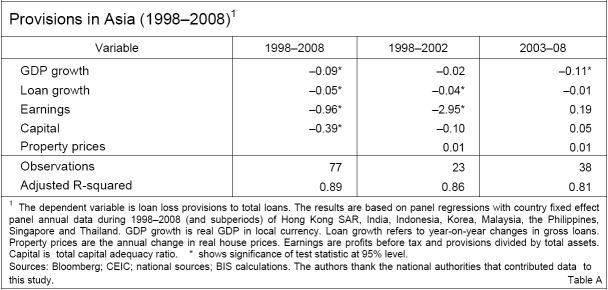Provisioning and financial system procyclicality
(Extract from pages 80-81 of BIS Quarterly Review, December 2009)
Research on loan loss provisioning used to focus narrowly from an accounting perspective on whether provisions were used by banks to smooth earnings (Greenawalt and Sinkey (1988)). More recently, work has focused on provisions' contribution to the procyclicality of financial systems by virtue of being lower when output and credit are expanding and higher in periods of contraction. In early work from this perspective, Borio et al (2001) document a strong negative correlation of bank provisions with the business cycle for 10 OECD countries. Subsequent empirical studies have used bank-level information to investigate the procyclicality of loan loss provisions in more detail (Cavallo and Majnoni (2002), Laeven and Majnoni (2003), Davis and Zhu (2005), Bikker and Metzemakers (2005), Bouvatier and Lepetit (2008)). Researchers use regression analysis to explain annual provisioning expenses, usually scaled by the total stock of loans or assets of the bank. Some of the explanatory variables used in these studies are discussed below.
GDP and credit growth. Provisioning expenses are found to vary negatively with the business cycle (real GDP growth) as well as credit growth. The latter result is consistent with provisions declining even as surges in new loans might indicate increased riskiness. Of the four studies that include both variables simultaneously, three find significantly negative coefficients on both; when only one or the other is included in other studies, it is invariably negative.
Earnings. If banks use provisions to smooth earnings, there should be a positive relationship between provisions and earnings. Evidence of the existence of earnings smoothing through provisions remains fairly strong, at least for industrialised countries. In a few papers, provisions are found to vary inversely with earnings when they are negative, which would contribute to procyclicality. Meanwhile, studies on emerging markets have not found evidence for earnings smoothing; in fact, earnings have been found to negatively affect provisioning in emerging Asia.
Capital ratio. Higher provisioning when capital is low is consistent with capital depletion being correlated with efforts to build up a greater reserve cushion. However, studies do not document a strong association with capital constraints and provisioning. In two of the four studies in which capital is included as an explanatory variable, there is no significant impact of capital on provisioning; in the other two studies the impact is of opposite signs.
Asset prices. Provisioning may be lower when asset prices are rising, if the latter are reflected in collateral valuations. (Changed expectations about future fundamentals are another channel.) Davis and Zhu (2005) find that provisions are lower when commercial property prices are rising. This suggests that provisioning may amplify credit cycles through the collateral channel.
The most ambitious study focusing on Asia is that of Craig et al (2006), who investigate the provisioning decisions of 300 Asian banks between 1996 and 2003. Their findings are consistent with the view that provisioning practices in Asia exacerbated financial system procyclicality more than in other regions. Higher real GDP, loan growth, asset prices and earnings led to lower provisions. To be sure, these results were probably driven by the collapse in many variables during the Asian financial crisis, when provisions needed to be increased.
Table A shows a preliminary attempt to explore the degree to which provisioning has been countercyclical in eight Asian countries, using system-wide data only, over 1998-2008. Regressions using annual data incorporating fixed country effects are reported above. Like Craig et al, we find over the full period that GDP and credit growth, earnings and capital are related to provisioning in a way that may exacerbate financial system procyclicality. However, when estimated over the more recent period only (2003-08), while GDP growth is statistically significant, other variables lose their significance. This suggests that many of the earlier results may have been driven by the behaviour of the variables around the Asian financial crisis of the late 1990s, and may not represent current provisioning practice. However, the paucity of observations and the lack of a full cycle in either subperiod limits the strength of any inferences to be drawn from the comparison.

